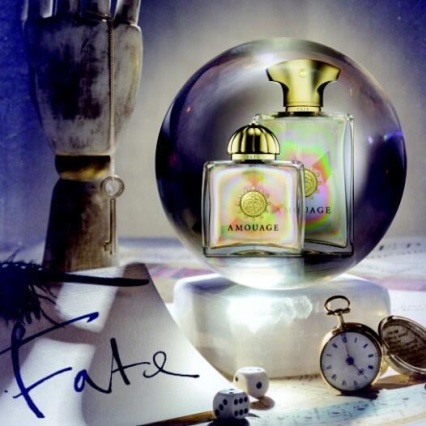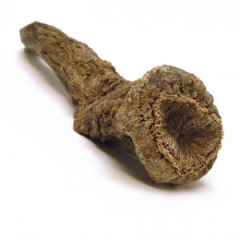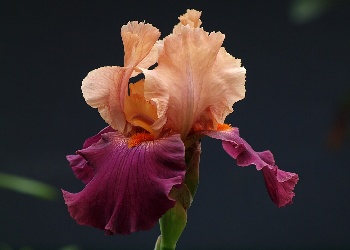Have you ever seen an Arabian horse running? It’s an object of awe and grandeur, from its tiny, delicately chiseled head with those vividly intelligent eyes, to its hugely curved, muscular neck, its perfect, lithe body, and its perpetual grace that puts all prima ballerinas to shame. My sister had a massive Arabian stallion called Sheytan, black as night, with a temper to match, and that half-wild, murderous devil was the terror of our stable boys (and many grown men). I had a Palomino, a handsome golden beauty of great age with a plodding nature. It was the only horse my parents would trust for a tiny four-year old and, though I loved him, I always wanted a black Arabian. I would console myself on sleepless nights by dreaming of riding a stallion like Sheytan in the desert, letting only the wind accompany the steady roar of his hoofbeats.

Source: dahabhorseridingclub.com
For some indescribable reason, I feel as though I’ve found a white Arabian in perfume form, and it’s Ubar from the royal perfume house of Amouage. Ubar isn’t a pure white steed but one flecked with yellow and gold, a larger-than-life, 3D, floral-oriental powerhouse whose mighty body also has a head of surprising delicacy. It is not a mere thoroughbred race horse; Ubar is too Oriental for that. It is definitely a mighty Arabian, and now I just need a desert in which to set it free.

Source: Friendfeed.com
Ubar is an eau de parfum that was released in 1995 to celebrate Oman’s Silver Jubilee year, and which made for Oman’s royal perfume house by Créations Aromatics. As First in Fragrance explains, the inspiration was the eponymous legendary city:
Ubar, also known as The City of a Thousand Pillars, existed from ca. 2,800 B.C. to ca. 300 A.D. According to legend the city amassed fabulous wealth from trading between the coastal regions of the Arabian peninsular and the population centres of the Middle East and Europe. Modern historians regarded Ubar as a figment of mythical Arabian tales and never thought that it really existed.
Ubar is mentioned in the fabulous tales from One Thousand and One Nights. According to legend God, enraged by its decadence and profligacy, smote the city, driving it into the sands, never to be seen again.
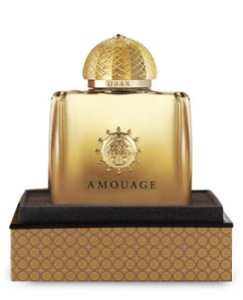
Ubar.
For some inexplicable reason, Amouage discontinued Ubar, before suddenly deciding to bring it back in 2009. Now Smell This has the details, along with the fabulous historical tidbit that the legendary city of Ubar was re-discovered in 1992 with the aid of satellite imaging. (Yes, I really do love history, even more than perfumery!)
Ubar has been relaunched this year (20091). It has new packaging (see image above), a new concentration (the original was an Eau de Toilette; now it’s an Eau de Parfum) and a new price (much higher). The notes (bergamot, lemon, lily of the valley, Damascena rose, Bulgarian rose, jasmine, sandalwood, synthetic civet and vanilla) are reportedly the same. […]
[H]ow does the new Ubar compare with the old? Well, first, I thought it was gorgeous in 2005, and it’s still gorgeous in 2009, but the change in concentration (and obviously, the reformulation) is significant: the new Ubar is a much heavier scent, with considerably more emphasis on the floral notes in the heart and correspondingly less emphasis on the base. The original Ubar was, to me, a sandalwood fragrance decorated with a few flowers; the new Ubar is a floral fragrance, first and foremost, with a woody oriental base[.]
The complete set of notes — as compiled from the official list on the Amouage website and from Fragrantica — are as follows:
top: lemon, bergamot, lily of the valley, tangerine, orange, litsea cubeba and violet leaf
heart: jasmine, damascene rose, orange blossom, ylang-ylang, tuberose, freesia, and palisander rosewood
base: civet, vanilla, sandalwood, patchouli, vetiver, copahu balm and black amber
According to my research on Fragrantica, Litsea Cubeba is an evergreen shrub native to China whose aroma is “lemon-like, sharp, tangy, with sweet undertone.” As for Black Amber, Fragrantica says it is the lowest, cheapest grade of ambergris. Copahu balm, for those who have never encountered it, is simply another type of very rich, spiced amber resin. Interestingly, if you examine that list of ingredients, the usual Amouage mainstay of frankincense is missing.
 Ubar opens on my skin with a burst of ruby-red, velvety, heavy, meaty rose. If this were meat, it would be a heaping slab of prime rib. It drips its hearty juices and jammy nectar atop a base of patchouli that almost feels infused with oakmoss. The mossy note feels midway between fresh and green, and dried, pungent and robust. Co-mingled with that rich damask rose is a subtle touch of orange blossom and big chunks of orange that feels both pulpy and infused with spice. The juicy flesh of the fruit adds another layer of richness to the jamminess of the rose, but any truly fruity aspects are alleviated by the lurking hints of delicate, dainty, sweet freesia and green, spring-like lily-of-the-valley.
Ubar opens on my skin with a burst of ruby-red, velvety, heavy, meaty rose. If this were meat, it would be a heaping slab of prime rib. It drips its hearty juices and jammy nectar atop a base of patchouli that almost feels infused with oakmoss. The mossy note feels midway between fresh and green, and dried, pungent and robust. Co-mingled with that rich damask rose is a subtle touch of orange blossom and big chunks of orange that feels both pulpy and infused with spice. The juicy flesh of the fruit adds another layer of richness to the jamminess of the rose, but any truly fruity aspects are alleviated by the lurking hints of delicate, dainty, sweet freesia and green, spring-like lily-of-the-valley.
In that opening blast, perhaps my favorite part are the subtle, spicy nuances in Ubar. It has to be the indirect effect of the Copahu resin which subtly adds a rich, thick, almost honeyed, but definitely spicy amber touch to the base. There is almost a boozy effect in those opening minutes — not like rum but, rather, like extremely expensive, aged cognac. There is a profoundly liqueur-like feel that smells wonderfully ostentatious, plush, hedonistically decadent and luxurious. At first, it is quite a separate, distinct note, but quickly, it melts into the perfume to become significantly muted, adding only an indirect touch of depth to that beefy, jammy, Damascus rose.
 Ten minutes in, green notes rise to the surface. It is not precisely like lily-of-the-valley because there is a heavy milky aspect to the floral greenness. In fact, it actually smells like a dead-on replication of extremely concentrated green tea, infused by a huge amount of cream. After another five minutes, the lactonic (and green tea) element fades, replaced by the clear, unquestionable note of lily-of-the-valley. It is infused with lemon and has a miniscule amount of spiciness underneath, thereby preventing it from ever being heavily soapy in nature. I assume that spicy-lemon nuance comes from the litsea cubeba. (As a side note, no other perfume house so consistently uses ingredients that I have never, ever heard of in all my life. It’s always a voyage of discovery with Amouage, and I find that enormously appealing.)
Ten minutes in, green notes rise to the surface. It is not precisely like lily-of-the-valley because there is a heavy milky aspect to the floral greenness. In fact, it actually smells like a dead-on replication of extremely concentrated green tea, infused by a huge amount of cream. After another five minutes, the lactonic (and green tea) element fades, replaced by the clear, unquestionable note of lily-of-the-valley. It is infused with lemon and has a miniscule amount of spiciness underneath, thereby preventing it from ever being heavily soapy in nature. I assume that spicy-lemon nuance comes from the litsea cubeba. (As a side note, no other perfume house so consistently uses ingredients that I have never, ever heard of in all my life. It’s always a voyage of discovery with Amouage, and I find that enormously appealing.)
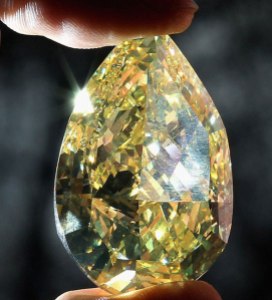
The famous, “Sun Drop” yellow diamond.
While the lemony lily-of-the-valley quietly makes its presence known, so too does the jasmine and, my word, is it stunning. It has the feel of night-blooming jasmine in full narcotic headiness with a sensuous aroma that feels almost tactile, reaching its floral tendrils across a warm summer’s night as if the floral fingers were waving at you in the air. It is so rich and strong, the note almost seems visually solid. In conjunction with that beefy, meaty, prime-rib of a rose, the overall effect feels like the perfume has turned into a floral holograph right before your eyes, shimmering in 3D effect like a revolving yellow diamond. (Jasmine always feels “yellow” to me, if that makes any sense, and I always have to remind myself that it is, in fact, a white flower. But, dammit, its richness feels so yellow, especially here!)
Amidst that heady blast of jasmine-rose, touched by lemony lily-of-the-valley, the other notes become much less individually distinct. Ubar’s patchouli can always be felt in the background, but the ambery, boozy note from the copahu resin receded long ago. And there is almost no strong feel of smoke and frankincense which is the usual signature for an Amouage fragrance. There feels like there are some flickers of frankincense, muted and almost indecipherable, but every time I think I’ve got a hold of the note, it vanishes. And I’m not the only one who wonder about its presence in Ubar. Now Smell This also struggled to decide whether or not it was there. Honestly, I wouldn’t be surprised if the subtle traces of some amorphous smokiness stemmed from the Copahu resin instead.

Source: Mearas.net
Around the forty minute mark, Ubar settles into its paces like an Arabian once it is in a full, comfortable gallop that it can maintain for hours. It is a perfectly blended, harmonious, monstrously big sum-total of: heady, exuberant flowers; lemony lily-of-the-valley; muskiness tinged with smoke; velvety, mossy patchouli; and subtle, almost minute flickers of spiced, pulpy orange. Like an Arab stallion racing in the desert, its footsteps kick out small traces of other notes, like pebbles or dust in the wind. There is civet which comes out from time to time like a teasing ghost. It’s never urinous, skanky, dirty or raunchy on my skin, but just another layer of muskiness that is added to the narcotic flowers. There are also subtle suggestions of sandalwood lurking at the edges but, at in the early hours, it never feels like real Mysore sandalwood. I honestly think it’s either synthetic or a variant, because it lacks the truly spicy, deeply complex, rich, layered feel of Mysore sandalwood. Still, it’s creamy and adds a subtle depth to very strong patchouli base. Hints of amber are also apparent at times but, like the other tertiary notes, it’s muted in the face of those powerful florals. Lastly, about two hours in, a quiet touch of soapiness arrives, underlying that lily-of-the valley note, but it soon fades away.
In its middle phase, Ubar becomes, primarily, a musky rose-jasmine fragrance whose other notes sing very softly in the shadows. At times, the whole thing feels like one extremely powerful, abstract burst of flowers backed by musk and patchouli. Yes, there is still some lemon nuances, but the fresh, spring, green Lily of the Valley element (that was never huge to begin with) disappeared around the middle of the third hour. The civet is noticeable, though it isn’t a profoundly distinct note beyond general muskiness at this stage. The sandalwood still feels very synthetic, muted, and vague. And, finally, on my skin, the amber effect is extremely indirect.
However, starting around the sixth hour, Ubar starts to shift a little. The jasmine-rose duet is joined by stronger animalic civet, followed by a touch of vanilla. The civet never smells urinous to me or like “cat-butt” as some of its detractors call it, but the note is strong, more than just general “muskiness,” and even a little sharp at times. Since it’s a synthetic ingredient for animal cruelty reasons, I’m not surprised that it burns my nose. As time passes, that softens a little, as does Ubar itself. It’s finally less voluminous in feel and projection, finally a little closer to the skin, and much more softly golden. Vanilla becomes more significant around the 8th hour, creating a warm, musky sweetness on the skin that remains until the very end.
I truly can’t say that the amber in the base or drydown is very profound, and I certainly don’t detect ambergris with its almost grey, sweaty, richly heavy, salty feel. The ambergris used in Ubar is the lowest grade called “Black Amber”; reading the Fragrantica which I linked to above, it seems to be an extremely soft form and I get the sense that it smells far from the real, hardcore whale ambergris. Furthermore, I’ve never read any accounts of Ubar where the reviewer thought amber (never mind ambergris) was a huge part of Ubar. There is a golden feel to the base in Ubar’s final stage, but it stems more from the lingering effect of the Copahu resin, mixed with the musky civet and vanilla than anything that smells “ambery.” When Ubar finally starts to fade away, all that’s left is some vanilla musk.
All in all, Ubar feels almost exactly as Luca Turin describes it. Yes, for once, I actually agree with the famed, prickly critic. In his gushing five-star review of Ubar in Perfumes: The A-Z Guide, he wrote:
I remember years ago seeing an iMax movie at the Air and Space Museum in DC: it started out with a grainy black and white film of a biplane taking off, and just when you thought you were beginning to wonder why you’d shelled out twenty bucks, the screen turned to colour, widened to a huge hollow sphere and you were flying above a forest in turning-leaf colors above a Pitts S2 painted in shiny red and white. Even the sound was gorgeous. Everyone went “aaaah” and I shed 40 years of age in 10 milliseconds. After smelling several dozen pigeon-toed, rickety modern fragrances designed by depressive accountants, encountering Ubar is a similarly joyful experience. This thing is so huge, gleaming, overengineered and chock-full of counterrotating planetary gears that you feel all you can do is let it tower over you while you walk around it and kick the huge tires. Ubar is technically a floral-oriental but the flowers are 3XL in size and the Orient has been scaled accordingly. If the old Dioressence had an illegitimate child with the first Rush, it would smell like this: a huge, purple romantic rose in the manner of the lamented Nombre Noir, a ton of creamy lactones, a whale’s worth of animalic amber. Ubar joins the small club of nuclear-tipped fragrances: Poison, Giorgio, Angel, Amarige. Use it carefully, for once you spray it on there’s no going back.
I can’t believe it, I actually agree with “His Majesty” in almost every respect! I only quibble on the “whale’s worth of animalic amber” since, on my skin, it is quite a subtle, indirect background thing. Notwithstanding that minor difference of opinion, I think the rest of Mr. Turin’s assessment is absolutely perfect, right down to how the “oriental” aspect has been scaled down to a small size.
He’s certainly right about Ubar being “nuclear-tipped.” This is one extremely powerful fragrance. Do not spray it with reckless abandon! Two to three small, dabbed smears gave me monstrously strong sillage at first but, after the first hour, it drops by a little. It doesn’t radiate out across a room at that point, but it does create a small, soft cloud around you, wafting about a 6 inches above your skin for hours and hours on end. You can definitely smell it on yourself, though I don’t think you’d overwhelm a co-worker across the room. (As a general rule, I would not recommend Ubar for a conservative office, no matter what the quantity.) Ubar only becomes a skin scent about 6.5 hours into its development and it lasts about 11.5 hours on my perfume-consuming skin. None of that applies, however, if you spray on a lot. More than 2-3 small sprays all over (remember that spraying amplifies a perfume due to aerosolization), and those around you will definitely notice. From a distance.
Though there is a lot of love for Ubar out there (even amongst those for whom lily-of-the-valley becomes a scrubber note), not everyone can handle it. The opinions on Fragrantica range from outright love, to occasional horror (due to the civet note), to those who admire it but find it far too big to wear:
- This is one of the ‘richest’, most luxurious perfumes I have ever tried. I don’t usually like civet, but in this composition, it was not unpleasant to me. It is an extremely smooth and long-lasting floral perfume.
- The only Amouage I dislike. It is so strong it gives me instant nausea. I think I am getting that “Mongoose” strongly”.
- Ubar is an extraordinary flowery fragrance, done on the Arab way. I smell something very close to agar wood note and some animal notes as well which I do not see listed here, but that is how it feels- untamed flowers, mostly violet leaves, greenish tuberose and jasmine.
- Love the topnotes, REALLY LOVE the drydown. I struggled a bit with the heart…For about 30 minutes, this beautiful creation smelled like celery and urine, though I don’t know which notes listed above would lend to the urine-like smell.
- Ubar by Amouage is all about flowers, it recalls many good big floral vintage perfumes I’ve already tried before, so if you love a good, bold and in your face floral you might want to give this a try. [¶] It opened with a big bucket of flowers, the smell itself is sharp, almost animalistic and very strong, it fills up a room and is not for pleasing a bus full with people :). [¶] The heart part on me is full with rich ylang-ylang, almost buttery, still going extremely strong and stays like this all trough the drydown – a rich, expensive smelling bomb of flowers – warm, elegant and inviting. [¶] Unfortunately like in many cases with Amouage – I find this to be too much, on the other hand – they do try to give what their customers paid for – a full and rich fragrance that simply screams “royal and expensive”.
- [From a male commentator]: I knew this was supposed to be floral, but it’s way too floral for my taste. I think the main culprit is the lily-of-the-valley, which is so strong that it overpowers the roses and jasmine, which I generally find pleasant. I can smell a little rose in the mix, but it’s not strong enough to balance the sharper white florals. I cannot smell the base at all due to the LOTV, which dominates everything throughout the entire development of the scent. [¶] I was hoping that at some point the base would make its way through, but the next morning I can still smell LOTV on my wrists. I have to say that this is a wearable LOTV, not a scrubber as many of them are for me, and it’s one I might choose if, for some unknown reason, I wanted a LOTV scent. The perfume is well-made, so I think anyone who loves pure florals of this type would enjoy Ubar.
I didn’t experience a particularly strong Lily-of-the-Valley note and certainly no “mongoose”-like or urinous civet, but I do agree with the general feel of many of the comments. Ubar is a total flowerbomb explosion that does scream out wealth, luxury, and opulence. It is absolutely over-the-top. And I completely share the opinion about how Ubar feels like a lot of vintage floral fragrances.

Source: Wallpapersget.com
In fact, in my notes, I wrote a long bit about Ubar’s retro and 1980s diva character because it is nothing short of a rearing, white Arab stallion. It is a perfume that feels incredibly classique, in a timeless, high-class, elegant, luxurious way. It’s so opulent, it’s retro, as if this were a 1970s or 1980s, big, diva perfume — only without the screeching element that some of those perfumes had. (Poison, I’m staring straight at you!) I think Ubar’s edges are softer, more well-rounded and creamy, but it’s all a very relative matter. Someone who likes “fresh, clean” fragrances would go into a coma with Ubar; those who can’t handle powerful, narcotically heady fragrances would probably pass out; and those who struggle with indolic, big, white florals would probably be completely overwhelmed. Ubar is stronger than (vintage) Fracas, and it reaches (vintage, 1970s) Opium levels of power.
I wouldn’t recommend Ubar to a lot of people. Those with the aforementioned perfume taste should stay far, far away. Those who are looking for an unobtrusive, versatile, office-friendly, and/or day fragrance — don’t even bother. Young women may also have problems with Ubar, as I’ve read a few people comment that it feels “old lady.” Yes, it definitely is for a more mature woman who wants something extremely sophisticated. And, lastly, in total honesty, I don’t think a lot of men would be comfortable wearing Ubar. It definitely tips heavily to the feminine side of things with all those powerful white florals. However, if you’re a man whose tastes aren’t limited to aromatic fougères, citrusy, gourmand, or oud-based fragrances, and if you enjoy big florals with powerful sillage and longevity, I would strongly urge you to sniff out Ubar.
As for me, I really enjoyed the heady splendour of Ubar with its enormous white beauty, but I prefer my Arabian horses to be Blacks, Bays, and Chestnuts with a little more of unisex smoke and spiciness in their nature. I would certainly wear Ubar if a bottle were ever to fall into my lap but, to my surprise, it is Amouage‘s Lyric that tempts me the most. It feels like a darker stallion with its spicy undertones, even though Lyric was primarily a ylang-ylang fragrance on my skin with hardly any rose. In fact, if I were to do a blind smell-test, based only on what I had heard of each fragrance, I’m sure I would have picked Ubar to be “Lyric” and Lyric to be “Ubar.” Ubar’s heavy, beefy, bloody, red rose presence is exactly what I had thought Lyric would be like (but wasn’t). On my skin, Lyric turned out to have very little rose but, instead, mostly bucketfuls of bewitchingly creamy, buttery, velvety ylang-ylang atop smoke, spices, and custardy vanilla. It just feels like it would fit better with Ubar’s golden bottle and image in my mind. Yet, even apart from the unexpected twist that it took on my skin, I much prefer Lyric because I think it has greater depth, complexity, and range than the primarily white floral aspects of Ubar.
If you’re tempted by Ubar, but put off by the brand’s steep prices, please know that there are ways around that; Amouage fragrances are often found at a huge discount at various, reputable, discount perfume retailers like LilyDirect. Ubar, in specific, is currently available for around $156 for a large 3.4 oz/100 ml bottle. (See, Details section, below.) For an Amouage, for the size, and for such a powerful eau de parfum, it’s truly an excellent deal. That large bottle will last you decades, unless you plan on spraying on more than 2-3 small spritzes over your entire body each time — in which case, the astronauts on the space station may sit up and wonder.
So give it a sniff if you’re looking for a sophisticated, seductive, diva, evening floral scent, and ride with the stallions to the ancient city of Ubar in the desert.
DETAILS:
Cost, Availability, Sales & Sets: Ubar is an eau de parfum that comes in two sizes: a large 3.4 oz/100 ml eau de parfum that costs $285, £170.00 or €215, or a small 50 ml/1.7 oz bottle that retails for $250, €185 or £150.00. Very few retailers carry the small size. LilyDirect, a very reputable online perfume retailer that frequently gives large discounts on Amouage, is selling a large 3.4 oz bottle of Ubar for only $156.08 instead of $285!!! That is an unbelievable price, especially given the free domestic shipping on orders over $100. (For Canadian readers, I’ve heard that LilyDirect will begin shipping to your country in June, so you may want to check with them then.) Ubar in the small 1.7 oz size is also on sale at Beauty Encounter for $163.49 with free domestic shipping and international shipping for a fee. (Obviously, you get more for cheaper from LilyDirect.) I’ve ordered from BeautyEncounter in the past with no problem, as have many of my friends, and they too are a very reputable dealer. Amazon seems to be selling Ubar via PlentyCosas and via FragranceNet with discounted prices of $163.54 for the small and $221 for the large bottle. If you were to go directly to FragranceNet the price is higher, depending on whether you want it boxed or not, at $200.19 for the small or $227.19 for the large. Otherwise, your first stop for purchase might be the Amouage website which sells Ubar in the small 50 ml/1.7 oz size for $250 as well as the larger size.
In the U.S., the authorized Amouage dealer is Parfums Raffy which sells Ubar in both sizes, including the smaller $250 bottle. There is free domestic shipping, and free Amouage samples with any order. Luckyscent carries only the large 3.4 oz/100 ml bottle of Ubar for $285. Ubar in the 3.4 oz/100 ml bottle can also be purchased online at Parfum1, MinNY, or the Four Seasons. Finally, Parfums Raffy sells a Mini Parfum Set of 6 Amouage fragrances (Ubar, Jubilation 25, Lyric, Gold, Dia, Reflection) in 7.5 ml crystal bottles for $280. MinNY sells the same Mini Set for $265.
Outside the US: OzCosmetics sells Ubar from Hong Kong (with free world shipping, it seems) and offers Ubar in the small 50 ml bottle for US$216.90 and in the large 3.4 oz bottle for US$246.90. In Canada, The Perfume Shoppe offers Ubar for USD$285 in the large 3.4 oz/100 ml bottle size. I think there is free worldwide shipping. Since CAD prices are usually higher, so you may want to drop them an email to inquire as to the Canadian rate. In the UK, Ubar is available at Les Senteurs where it costs £150.00 or £170.00, depending on size. Samples are available for purchase. There is also an Amouage boutique in London, and I’ve read that some people have purchased Ubar at Harrods (probably in the Roja Dove speciality boutique). In France, Ubar is sold at Jovoy Paris for €210 for the large 3.4 oz/100 ml bottle. For the rest of Europe, Premiere Avenue in France carries the full line of Amouage products, from perfumes to candles to body products. Like everything else it carries, Premiere Avenue will ship worldwide. (Send an email to info@eurl3.com for shipping costs.) In Germany, Ubar is available at First in Fragrance where it costs €190 or €270.00 (which is much higher than the €215 listed on the Amouage website) with free shipping within the EU and shipping elsewhere for a fee. In Australia, Au.StrawberryNet sells the small 1.7 oz/50 ml bottle of Ubar for AUD$223.50. For other countries, the Amouage website has a “Store Finder” which should, hopefully, help you find the perfume somewhere close to you.
Samples: Surrender to Chance sells Ubar at prices start at $3.99 for a 1/2 ml vial. Samples are also available at a few of the retailers listed above, where mentioned.


Fate for Woman is a chypre oriental with a rich floral heart intensified by a dark and destructive accord resonating with the tumultuous unknown.
 Fate opens on my skin with a burst of yellow: fresh, crisp citrus notes, and the sunniest of daffodils. There is a momentary flicker of something sour that is soon replaced by spiciness, rose infused with patchouli, oakmoss, stirrings of a quiet, soft leather note, and a touch of musk. The oakmoss is a subtle swirl of nuances: fresh, green, slightly mineralized, and grey. The castoreum is smooth, warm, ever so slightly animalic, and sweet.
Fate opens on my skin with a burst of yellow: fresh, crisp citrus notes, and the sunniest of daffodils. There is a momentary flicker of something sour that is soon replaced by spiciness, rose infused with patchouli, oakmoss, stirrings of a quiet, soft leather note, and a touch of musk. The oakmoss is a subtle swirl of nuances: fresh, green, slightly mineralized, and grey. The castoreum is smooth, warm, ever so slightly animalic, and sweet. 






